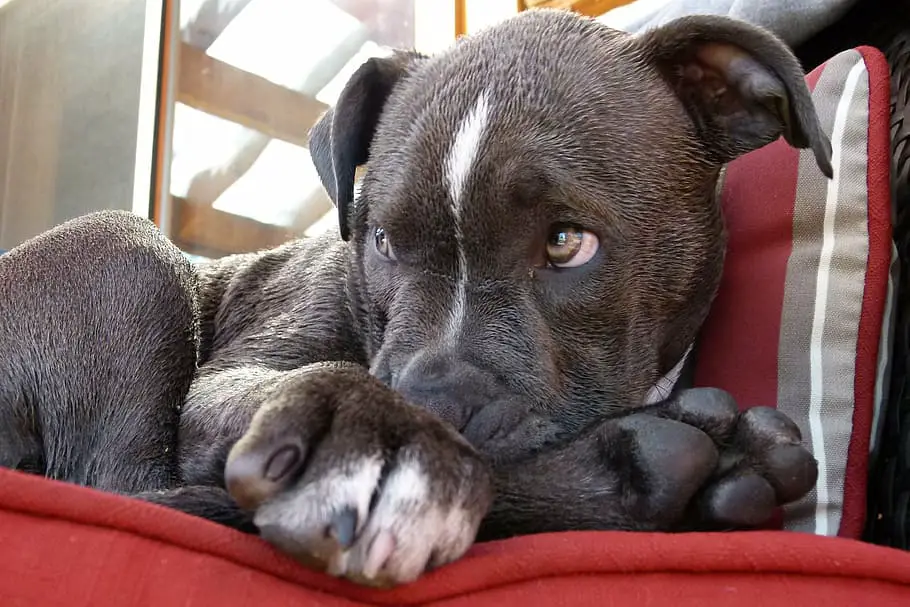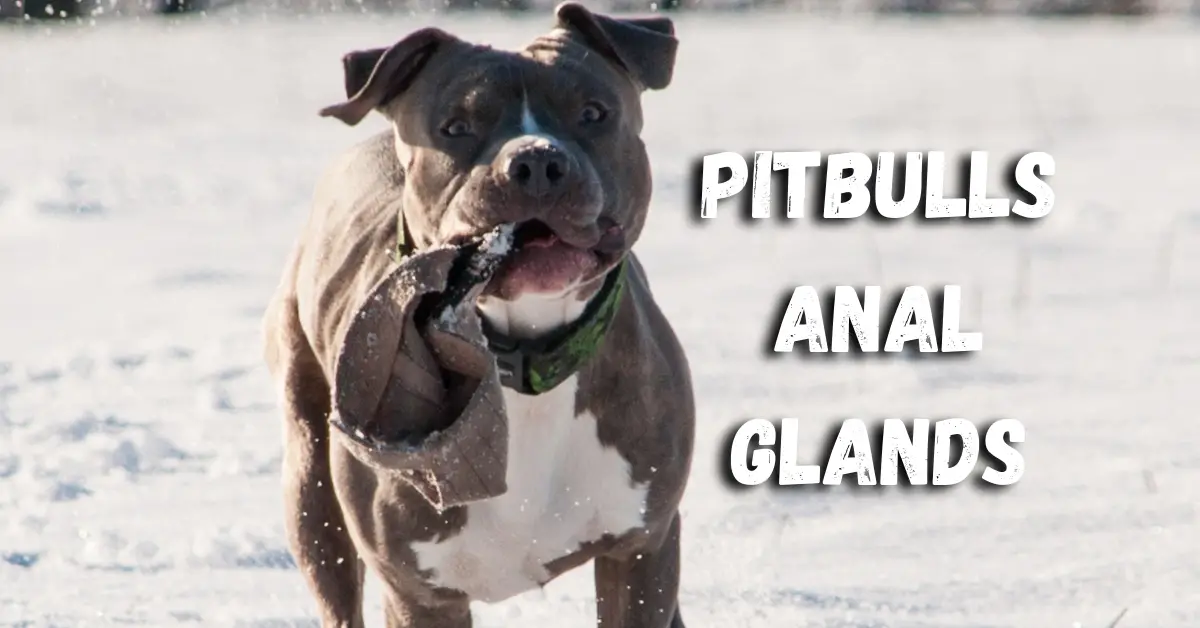If you’re a pitbull owner, you’re likely familiar with the breed’s strong, muscular physique and playful, loyal personality.
However, like all dogs, pitbulls are susceptible to various health issues. One common problem that many pitbulls face is anal gland problems. While this topic may not be the most glamorous, it’s essential to understand the symptoms and treatment options to ensure your furry friend stays healthy and happy.
In this article, we’ll explore everything you need to know about pitbull anal gland problems.
What are Anal Sac Disorders?

Anal sac disorders are medical conditions where the anal glands of a pitbull become blocked or infected. The blockage or infection can cause swelling and pain around the anus of your pet, as well as potentially other symptoms such as loss of appetite, scooting on its backside, excessive licking of its bottom, discharge from the anal area, and even occasional vomiting.
Anal gland disorders occur when the two small glands located near the anus become inflamed or overly full. These glands produce a fluid that is used for scent marking and territorial marking when your pet defecates. When these glands become blocked, it can lead to a painful and uncomfortable situation for your pet.
In many cases, the infection or blockage can be cleared with antibiotics prescribed by your veterinarian. If the issue persists and becomes chronic, surgery may be recommended to remove the glands completely.
It’s important to note that anal sac disorders are not unique to pitbulls; any breed of dog can be affected by this condition. However, pitbulls have a higher incidence of anal sac problems due to their wide-set tail base and short coat length, which makes them more susceptible to impacted gland issues.
Symptoms of Anal Sac Disorders in Pitbulls
The symptoms of anal sac disorders can vary depending on the specific condition affecting your pitbull’s anal glands. However, some common signs to look out for include the following:
Scooting
If your pitbull is dragging its bottom across the ground, it could be a sign of an anal sac disorder. Scooting is often one of the earliest signs of a problem and can occur when the anal glands are blocked or infected.
Monitoring this behavior is important as scooting can indicate painful inflammation and swelling in the area around the anus. Your pet may also be trying to relieve pressure or discomfort by dragging its bottom across the ground.
Licking and Chewing
If your pitbull is excessively licking or chewing its bottom, it could be a sign of an anal sac disorder. This can occur when the anal glands become inflamed or infected, and the dog experiences some discomfort.
Your pet may try to relieve this pain by licking and/or chewing at the area around its anus. It’s important to observe this behavior as excessive licking or chewing can create sores that further exacerbate any existing problems with the anal glands.
Foul Odor
Anal gland fluid has a strong, unpleasant odor that is unmistakable. This foul odor is one of the most common symptoms of anal sac disorders in pitbulls and can be a sign that something is wrong with your furry friend. If you notice a particularly sharp or putrid smell coming from your pet’s anus, it could indicate an issue with its anal glands.
The strong smell indicates an infection or blockage of the glands that can cause discomfort and pain for your pet. In addition to causing an unpleasant odor, the infection or blockage can lead to excessive licking and chewing of the area, as well as scooting on its backside.
Pain and Discomfort
Anal sac disorders often cause pain and discomfort around the anus area. If your pitbull is exhibiting signs of pain or discomfort, it could be a sign that they are suffering from an anal gland disorder. This can include signs such as whimpering, difficulty sitting down, or licking excessively at the area around the anus.
It’s important to monitor your pet for signs of pain and discomfort, as anal sac disorders can be painful and require veterinary attention. If left untreated, the infection or blockage can worsen over time and may even require surgery in some cases.
Swelling
If the anal sacs become inflamed or infected, you may notice swelling around your pitbull’s tail area. This swelling can indicate an anal gland disorder and should be monitored closely as it can be a sign of a more serious problem.
If your pet is experiencing any of these symptoms, it’s important to seek veterinary attention as soon as possible. Anal sac disorders can be painful and uncomfortable for your furry friend and require treatment in order to resolve the issue.
Causes of Anal Sac Disorders in Pitbulls

There are several causes of anal sac disorders in pitbulls. Some of the most common causes include:
- Poor Gastrointestinal Health: Digestive problems such as constipation can lead to blocked anal glands.
- Allergies: Allergies can cause inflammation and itching around the anal area, leading to excessive licking and scooting.
- Loose, Soft, or Small Stool: Dogs with soft or small stool may not be able to empty their anal glands properly, leading to a buildup of fluid.
- Breed Predisposition: Some breeds, including pitbulls, are more prone to anal gland problems than others.
- Age: Older dogs may be more susceptible to anal gland issues due to decreased muscle tone around the anal area.
Diagnosis and Treatment of Anal Sac Disorders in Pitbulls
If you suspect your pitbull has an anal gland problem, you must take them to the vet for a proper diagnosis. The vet will perform a physical exam and may use a gloved finger to feel the anal glands for abnormalities. They may also take a sample of the fluid for analysis.
Treatment for anal gland disorders can vary depending on your pitbull’s specific condition. In some cases, the vet may manually express the anal glands to remove the fluid buildup. Antibiotics may be prescribed to treat infections, and anti-inflammatory medications may be used to reduce swelling and inflammation.
In more severe cases, surgery may be necessary to remove the anal sacs completely. This procedure is known as anal sac removal or anal sacculitis. While it may seem extreme, it’s important to remember that removing the anal sacs will not affect your pitbull’s quality of life and can prevent further health complications.
How to Prevent Anal Sac Disorders in Pitbulls
Preventing anal sac disorders in pitbulls is essential for maintaining their health and happiness. Here are some tips to help prevent anal sac problems in your furry friend:
- Provide a Balanced Diet: A balanced diet that includes plenty of fiber can help regulate your pitbull’s bowel movements and prevent constipation.
- Encourage Exercise: Regular exercise can help promote healthy bowel movements and prevent constipation.
- Groom Regularly: Keeping your pitbull’s anal area clean and well-groomed can help prevent infections and inflammation.
- Monitor Stool Consistency: Keep an eye on your pitbull’s stool consistency and speak to your vet if you notice any changes.
- Visit the Vet Regularly: Regular check-ups with your vet can help identify any potential health issues early on, including anal gland problems.
Conclusion
While anal gland problems may not be the most pleasant topic to discuss, it’s important for pitbull owners to understand the symptoms and treatment options to ensure their furry friends stay healthy and happy.
If you notice any signs of anal gland problems in your pitbull, be sure to take them to the vet for a proper diagnosis and treatment. With proper care and attention, you can help prevent anal gland problems in your furry friend and ensure they live a long and healthy life.

